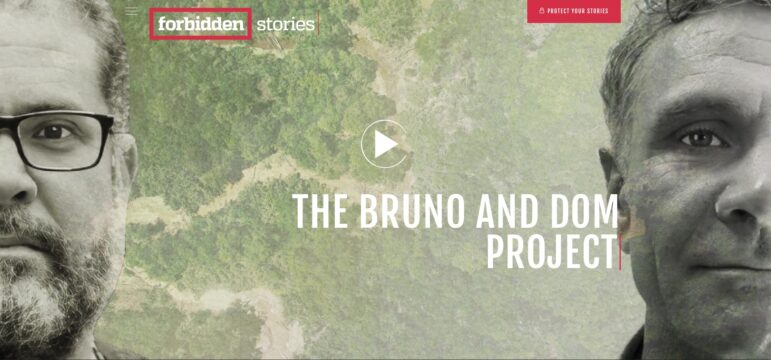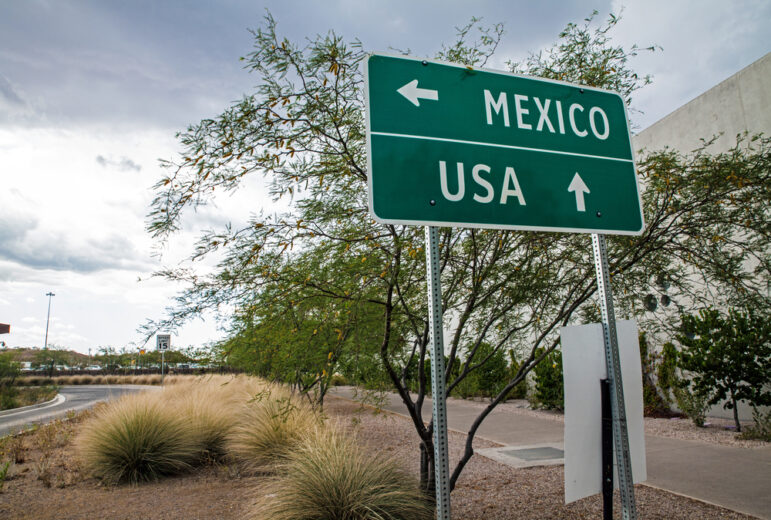

From Source to Table: How Journalists Are Investigating Food Stories Worldwide
Read this article in

A coffee plantation in Brazil, where reporters are shedding light on destructive environmental practices and labor abuses. Image: Shutterstock
Late in the summer of 2021, Midwest Center for Investigative Reporting journalist Madison McVan flew out to an Oklahoma town, home to one of the largest meatpacking plants in the country.
Her trip began months earlier with a press release from a union about COVID-19 working conditions in the Seaboard Foods plant. While interviewing workers, she began to uncover a troubling culture of ignoring employee injuries that predated the pandemic.
Worker safety is just one part of McVan’s beat. As a reporter who covers the meat industry, McVan follows food from the pasture to the grocery store shelf. “Anything that’s tied to that supply chain is within my realm,” she explains.
Food, often covered from a cultural lens, is increasingly garnering the attention of investigative journalists looking at what goes into getting a meal to a plate. Journalistic scrutiny is bringing to light the environmental impacts, labor conditions, health repercussions, and political influence linked to food.
“This is a system at work, and journalistically you have to understand all the elements of these kind of systemic factors,” notes Mark Schapiro, an investigative journalist who reports on agriculture and the environment.
The Power of Food
When Schapiro began covering pesticides early in his career, he didn’t think of it as a food story. He saw it as an issue of public health. Schapiro said he wasn’t interested in writing about food; he wanted to report on political and economic power.
But eventually, he came to understand that “the issue of food is a question of economic and political power.”
Schapiro, author of the book “Seeds of Resistance” and lecturer at the University of California at Berkeley Graduate School of Journalism, says that over the last decade there has been a “flowering” of reporting focused on the food system.
Some outlets, like the Food and Environment Reporting Network (FERN) and Civil Eats, focus entirely on food — its production, distribution, and access to it. The food system is also getting attention from publications with broader environmental scopes, Schapiro noted, like Inside Climate News and the Guardian.
Labor conditions throughout the supply chain are another major issue, from farmworker rights to the lack of COVID-era protections in processing facilities. The City won the investigative reporting category of the 2022 James Beard Awards for reports about food delivery workers in New York City. New York Magazine/The Verge was shortlisted for investigating the same topic.
“People are starting to realize that reporting on the food system hits every beat or every discipline out there,” Schapiro says.
Many investigations into aspects of the food industry highlight links between grocery store shelves and the influence of large corporations. A 2020 story by the Bureau of Investigative Journalism showed how the supply chain of the US food giant Cargill was linked to vast deforestation in Brazil and allegations that a farm supplying Cargill had used child labor (Cargill denied any wrongdoing). In a three-part series, Oxpeckers Center for Investigative Environmental Journalism looked at the use, impact, and regulation of genetically modified crops across Africa. Stéphane Horel, a French author and investigative journalist for Le Monde, revealed the influence of corporations like Monsanto and documented the harmful impacts of pesticides.
Some stories show the impacts of demand for certain foods, nearby and on the other side of the globe. In 2021, environmental news site Mongabay and Japan’s investigative nonprofit Tansa, along with the Environmental Reporting Collective, partnered on an investigation into abusive working conditions on fishing vessels belonging to Chinese tuna company Dalian Ocean Fishing. Another 2021 Mongabay project revealed the impact of European fishing practices on yellowfin tuna in the Indian Ocean. Netherlands-based outlet Lighthouse Reports highlighted poor treatment of migrant farmworkers in Europe during the pandemic.
By looking at food as a large system, journalists can identify the connections and interests that shape how it is produced and distributed, Schapiro explains. When starting to report on pesticides, it can seem obvious to focus on the farmers who are using harmful chemicals on their farmland. But it’s critical to see that farm in its full context.
“You follow that trail from one farm applying one set of toxic substances and you end up in some of the biggest, most powerful commodity companies, and then the most powerful investor operations,” he notes.
Food Stories Are Climate and Biodiversity Stories
When FERN launched 10 years ago, it didn’t start out with a mission to cover climate change, according to executive editor Brent Cunningham. The nonprofit news organization aimed to fill a need for deep and serious coverage of the food sector, as newsroom budget cuts reduced agriculture reporting staff.
But a decade later, it has become clear that the food system is deeply connected with the global climate and biodiversity crises. Almost a third of all greenhouse gas emissions come from the food and agriculture sectors, according to the UN Food and Agriculture Organization, and agriculture is the main threat to 86% of all species at risk of extinction, according to a 2021 UN Environment Program report. These days, Cunningham said, almost every FERN story has at least some connection to these major environmental issues.
“I think there’s just this growing realization that if we don’t do something sort of systematic in terms of our approach to agriculture, we’re never going to be able to fully mitigate climate change,” Cunningham adds.
FERN operates on a partnership model, publishing almost all stories with other media outlets. Recipes and restaurant features fall outside of its purview, but FERN looks at the food system from just about every other angle, from fishery sustainability to the viability of carbon farming, to a grassroots German movement to preserve biodiversity to the implications of the end of pandemic-era benefits to address food insecurity.
In a 2021 investigation published with Reveal, the publishing and broadcast platform of the Center for Investigative Reporting, journalist Teresa Cotsirilos examined a California program that allows farms to keep workers on the job when the area is under a mandatory evacuation order due to wildfires.
Cotsirilos, who is based in California, had built a network of sources related to agriculture in the state and heard people raising complaints about the program, Cunningham recounts. The story prompted Sonoma County to review the “Ag Pass” program.
Other FERN stories have been more driven by data — or a lack thereof, according to Cunningham. As part of an investigation with the Midwest Center for Investigative Reporting and the Guardian, FERN found that North Carolina had records of only 33 public complaints against livestock operations across 10 years — a sharp contrast to other hog-farming states that had thousands over a similar time period. For years, complaints about mismanagement of hog waste to North Carolina authorities had just disappeared.
Part of FERN’s mission is to give journalists, often freelancers, the time and resources to do the type of in-depth reporting that results in impactful stories. Cunningham emphasizes that most of the outlet’s stories rely on the kind of “old-fashioned storytelling” that involves shoe leather, source-building, and lots of phone calls.
“It’s not a trick or a secret or something that people don’t already know,” Cunningham says. “It’s just taking the time.”
Reporting on a Booming Industry
In Brazil, where agriculture is a powerful economic sector, reporters are shedding light on destructive environmental practices and labor abuses.
“The world feeds on the food that comes from Brazil,” Ana Aranha, special projects editor at Reporter Brásil, notes. The country is a top exporter of soybeans, beef, chicken, sugar, and more, and was estimated in 2020 to have fed roughly 10% of the globe’s population. However, Aranha says, people are not widely aware of what goes into producing that food.
Investigative nonprofits Repórter Brasil and Agencia Pública teamed up in 2018 to launch Por Trás Do Alimento (“Behind the Food”), a project focused on the use of pesticides across the country’s agriculture industry.
This project has reported on how pesticides banned in Europe because of their impacts on bees were sold to Brazil, how a major grocery chain has been fined for selling produce contaminated with pesticides over the legal limit, and how landowners weaponized pesticides in an attempt to drive local communities off disputed land.
Stories about pesticides are difficult to report, Aranha explains. Accessing data is often a challenge. One helpful strategy she has employed has been to build trust with sources in the middle levels of large agribusinesses, who see both what is involved in the production side of the industry and how it is presented to consumers. Employees in these positions who are unhappy with the company’s activities can become useful resources for journalists, according to Aranha.
Meanwhile, more journalists are probing other facets of Brazil’s booming agriculture industry. Reporter Brásil has uncovered “slave-like” labor conditions at a cocoa bean supplier for international chocolate companies, and, in partnership with the Guardian, reported on connections between the world’s largest meat company and deforestation in the Amazon.
Aranha says that reporting on food production in Brazil often feels like covering “two different universes.” In the market, the food is beautiful, and the technology appears advanced. But in the field, she sees the difficult labor conditions, the degradation of rivers and forests, and the communities being pushed out to make way for more agribusiness.
“It feels like a different time or a different world, you know, like they don’t belong together,” Aranha says. “How can these two be part of the same chain? It’s so strange every time I come back from these trips, and I say, this is actually where our food is coming from, and this is what’s happening there.”
A Massive Industry
At the Midwest Center for Investigative Reporting, McVan takes a broad view of the meat industry beat. She has reported on how fertilizer runoff linked to livestock disproportionately harms drinking water in low-income communities, and how former US Agriculture Secretary Sonny Perdue lobbied to keep meatpacking plants open in the early weeks of the pandemic, despite the risks to workers.
In June 2021, she covered how some prison work release programs at meatpacking plants continued during the pandemic. Prisoners moved between the two high-risk settings, creating potential for large outbreaks in both the prison and among plant employees. McVan learned about the situation from a line in emails between public officials that the outlet obtained through a Freedom of Information Act request.
Public records are a big part of McVan’s strategy for covering the meat industry. In towns and regions where a company is a major player in the local economy, she’s had success by requesting communications between a public agency and any emails from the company’s domain name.
She adds that the US Department of Agriculture website is also a valuable resource, providing granular trade data for the US and trading partners. She’s also used reports that USDA staff have compiled about agriculture in other countries, like Ukraine.
McVan is particularly interested in labor conditions in the industry, which employs many immigrants, refugees, and people of color.
“When you think about the number of people that work in the food industry somehow, whether they’re farmworkers, or they work in food processing plants, or meatpacking plants, or in grocery stores or in restaurants, I mean, it’s just a massive, massive industry,” she notes.
For reporting on labor conditions within the food industry, McVan emphasizes that it is key to develop trust with people working in processing plants — as she did with her Seaboard Foods investigation. McVan, who conducts many interviews in Spanish — the native language of many of the food industry workers in the area — says she’s always careful to be very upfront with sources. When she introduces herself, she explains why she thinks the story is important and makes sure people know that they are not obligated to speak with her — a strategy she feels to be both ethical and helpful when building a relationship with a source.
Ultimately, McVan says food corporations deserve the same level of scrutiny that other businesses or government agencies get. “We can’t lose sight that these food companies are major corporations, like Amazon or Facebook,” she says.
By the time a meal makes it to a kitchen table, the environmental impacts, labor conditions, and corporate interests that went into producing that food are not always apparent to consumers, Aranha points out.
“We’re talking about what you put in your mouth, about how much you spend on food, about your health,” she says. “It is connected, but it takes a long way, you know, to find the roots.”
Additional Resources
The Nonprofit News Site Taking on Agribusiness in the US Heartland
The Rise of Science-Based Investigative Journalism
 Elizabeth Hewitt is an independent journalist currently based in the Netherlands. Her work has appeared in National Geographic, Columbia Journalism Review, and Civil Eats, among others. She previously contributed to the US Press Freedom Tracker and worked as a reporter and editor for the nonprofit news site VTDigger.org.
Elizabeth Hewitt is an independent journalist currently based in the Netherlands. Her work has appeared in National Geographic, Columbia Journalism Review, and Civil Eats, among others. She previously contributed to the US Press Freedom Tracker and worked as a reporter and editor for the nonprofit news site VTDigger.org.












